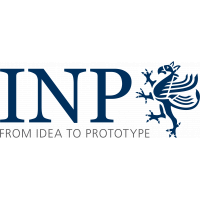A self-consistent fluid model has been successfully developed and employed to model an electron cyclotron resonance driven hydrogen plasma at low pressure. This model has enabled key insights to be made on the mutual interaction of microwave propagation, power density, plasma generation, and species transport at conditions where the critical plasma density is exceeded. The model has been verified by two experimental methods. Good agreement with the ion current density and floating potential – as measured by a retarding energy field analyzer – and excellent agreement with the atomic hydrogen density – as measured by two-photon absorption laser induced fluorescence – enables a high level of confidence in the validity of the simulation. The dataset contains most of the simulation and measurement data presented in the related paper publication.
| Field | Value |
|---|---|
| Group | |
| Authors | |
| Release Date | 2022-10-10 |
| Identifier | dc66dc03-a157-4179-8d8c-19999bcfe8ff |
| Permanent Identifier (DOI) | |
| Permanent Identifier (URI) | |
| Is supplementing | |
| Plasma Source Name | |
| Plasma Source Application | |
| Plasma Source Specification | |
| Plasma Source Properties | Electron cyclotron resonance (ECR) coaxial plasma source AURA-WAVE (Sairem): microwave frequency excitation 2.45 GHz, applied power range 50 – 150 W, volume of the plasma reactor about 70 l. |
| Plasma Medium Name | |
| Plasma Medium Properties | Hydrogen with a gas purity of 6.0 and a flow of 100 sccm is kept constant at a pressure of 5 Pa and 7 Pa, respectively. |
| Plasma Diagnostics Name | |
| Plasma Diagnostics Properties | The low-pressure hydrogen plasma driven by the commercial ECR source was investigated by a self-consistent fluid model which is implemented in Comsol Multiphysics. The model includes equations for the permanent magnetic field, the microwave field and fluid equations to describe the plasma generation. The stationary spatially homogeneous electron Boltzmann equation is solved once to determine the rate coefficients of reactions between electrons and heavy particle as functions of the mean energy. The static magnetic field is determined for each geometric configuration in advance. The remaining equations describing the microwave and the plasma are solved in a coupled system where the electron density and the absorbed power determine the coupling between the microwave and plasma parts. Two-photon absorption laser induced fluorescence (TALIF) was used for the detection of hydrogen atoms. For this photons with a wavelength of 205 nm are created through the combination of a frequency doubled Nd:YAG pump laser (Spectra Physics, Quanta Ray), with a pulse width of 6 ns, and with a dye laser (Sirah, Precision Scan SL). The 615 nm red light from the dye laser is frequency doubled with the help of a BBO crystal, and then remixed with residual red light from the dye laser in a second BBO crystal for sum-frequency generation to the required 205 nm radiation. For the detection of the fluorescence a Nikon lens systems was used to image a region of interest of about 10 and 2 mm in the horizontal and vertical distances respectively. As a detector a gateable ccd camera was used (Andor iStar DH734x) in combination with a spectral filter providing a bandwidth of 10 nm centered at around 656 nm for hydrogen and 825 nm for krypton respectively. The absolute atomic hydrogen densities could be derived from the fluorescence by calibrating the appropriate fluorescence using krypton. A retarding field energy analyzer (RFEA) was employed for the measurement of the total ion current in the plasma. A separate bias can be applied to the front electrode to use the RFEA as a planar probe. The floating potential Vf was determined from the current voltage characteristics as measured by the front electrode. From this, an estimation for the ion current density at Vf was calculated by using a simplified linear extrapolation of the far ion saturation branch at floating potential Vf. For the measurements, the RFEA probe is positioned along the axis of symmetry of the ECR source at various distances in the range from 10 to 25 cm by means of a UHV-manipulator which is mounted at the back flange of the chamber. |
| Language | English |
| License | |
| Public Access Level | Public |
| Contact Name | Florian Sigeneger |
| Contact Email |
Data and Resources
- Verified modeling of a low pressure hydrogen plasma generated by electron cyclotron resonance - Fig. 8csv
Species densities along the axial cut at r = 12 mm. The data are given in a...
Preview Download - Verified modeling of a low pressure hydrogen plasma generated by electron cyclotron resonance - Fig. 10acsv
Comparison of calculated and measured results for the probe current density...
Preview Download - Verified modeling of a low pressure hydrogen plasma generated by electron cyclotron resonance - Fig. 10bcsv
Comparison of calculated and measured results for the probe current density...
Preview Download - Verified modeling of a low pressure hydrogen plasma generated by electron cyclotron resonance - Fig. 11acsv
Comparison of calculated and measured results for the floating potential at...
Preview Download - Verified modeling of a low pressure hydrogen plasma generated by electron cyclotron resonance - Fig. 11bcsv
Comparison of calculated and measured results for the floating potential at...
Preview Download - Verified modeling of a low pressure hydrogen plasma generated by electron cyclotron resonance - Fig. 12csv
Comparison of the calculated and measured dependence of the probe current...
Preview Download - Verified modeling of a low pressure hydrogen plasma generated by electron cyclotron resonance - Fig. 13acsv
Comparison of calculated and measured results for the H density at 5 Pa. The...
Preview Download - Verified modeling of a low pressure hydrogen plasma generated by electron cyclotron resonance - Fig. 13bcsv
Comparison of calculated and measured results for the H density at 7 Pa. The...
Preview Download

![[Open Data]](https://assets.okfn.org/images/ok_buttons/od_80x15_blue.png)